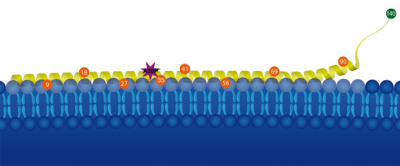
In a complex series of experiments, chemists from the University of Konstanz examined what the effects were of changing a single amino acid in the alpha-synuclein protein. They were able to prove how this smallchange disturbs the binding of alpha-synuclein to membranes. “We hope that the finding of this selectively defective membrane binding will help us to understand how Parkinson’s develops on a molecular level. Ultimately, this will facilitate the devising of therapeutic strategies”, outlines Julia Cattani, a doctoral student. The research results were revealed in the Journal of the American Chemical Society.
The human brain contains large quantities of the small alpha-synuclein protein. Its exact biological function is still unknown, yet it is closely linked to Parkinson’s disease; the protein “clumps together” in the nerve cells of Parkinson patients. Alpha-synuclein consists of a chain of 140 amino acids. In rare cases Parkinson’s disease is hereditary; where this occurs one of these 140 components has been replaced. Malte Drescher and his working group in the Department of Chemistry at the University of Konstanz have now found out the influence these selective changes in the protein sequence can have on the behaviour of alpha-synuclein. “We can show that the selective mutations disturb the membrane binding of alpha-synuclein on a local level”, explains Malte Drescher.
To find out more about the influence of selective mutations, the Konstanz-based chemists Dr Marta Robotta and Julia Cattani applied magnetic probe molecules to various places on the alpha-synuclein protein. With the help of electron paramagnetic resonance spectroscopy, the researchers were able to measure the rotation of these nanomagnets. At every residue at which alpha-synuclein binds to a membrane, the rotation slows down. In this way they were able to find out precisely when and where a binding to the membranes takes place—and when it does not. In the case of the exchanged amino acids they discovered a disturbance of the membrane binding of alpha-synuclein—an important clue for the molecular context of Parkinson’s disease.
“We went to great lengths, performing over 200 spectroscopic experiments, the results of which we compared with our models by means of a specially developed simulation algorithm. The outcome certainly compensated our efforts”, says Julia Cattani.

